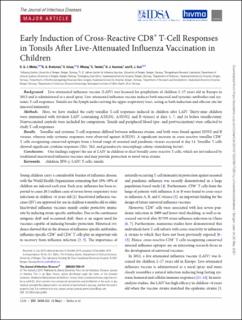Early Induction of Cross-Reactive CD8+ T-Cell Responses in Tonsils After Live-Attenuated Influenza Vaccination in Children
Mohn, Kristin Greve-Isdahl; Brokstad, Karl Albert; Islam, Shahinul; Oftung, Fredrik; Tøndel, Camilla; Aarstad, Hans Jørgen; Cox, Rebecca Jane
Journal article, Peer reviewed
Published version

Åpne
Permanent lenke
https://hdl.handle.net/11250/2756455Utgivelsesdato
2020Metadata
Vis full innførselSamlinger
- Department of Clinical Science [2318]
- Registrations from Cristin [9791]
Sammendrag
Background
Live-attenuated influenza vaccine (LAIV) was licensed for prophylaxis of children 2–17 years old in Europe in 2012 and is administered as a nasal spray. Live-attenuated influenza vaccine induces both mucosal and systemic antibodies and systemic T-cell responses. Tonsils are the lymph nodes serving the upper respiratory tract, acting as both induction and effector site for mucosal immunity.
Methods
Here, we have studied the early tonsillar T-cell responses induced in children after LAIV. Thirty-nine children were immunized with trivalent LAIV (containing A/H1N1, A/H3N2, and B viruses) at days 3, 7, and 14 before tonsillectomy. Nonvaccinated controls were included for comparison. Tonsils and peripheral blood (pre- and postvaccination) were collected to study T-cell responses.
Results
Tonsillar and systemic T-cell responses differed between influenza strains, and both were found against H3N2 and B viruses, whereas only systemic responses were observed against A/H1N1. A significant increase in cross-reactive tonsillar CD8+ T cells recognizing conserved epitopes from a broad range of seasonal and pandemic viruses occurred at day 14. Tonsillar T cells showed significant cytokine responses (Th1, Th2, and granulocyte-macrophage colony-stimulating factor).
Conclusions
Our findings support the use of LAIV in children to elicit broadly cross-reactive T cells, which are not induced by traditional inactivated influenza vaccines and may provide protection to novel virus strains.
